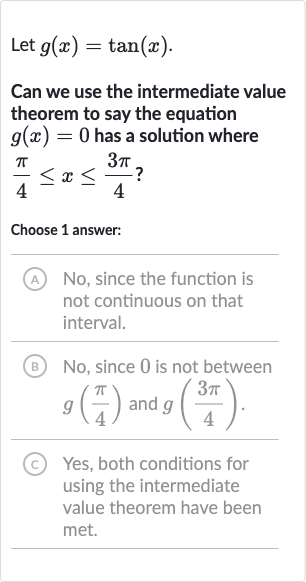AI tutor
Welcome to Bytelearn!
Let’s check out your problem:

Let .Can we use the intermediate value theorem to say the equation has a solution where ?Choose answer:(A) No, since the function is not continuous on that interval.(B) No, since is not between and .(C) Yes, both conditions for using the intermediate value theorem have been met.
Full solution
Q. Let .Can we use the intermediate value theorem to say the equation has a solution where ?Choose answer:(A) No, since the function is not continuous on that interval.(B) No, since is not between and .(C) Yes, both conditions for using the intermediate value theorem have been met.
- Understand IVT: Understand the Intermediate Value Theorem (IVT). The IVT states that if a function is continuous on a closed interval and is any number between and , then there is at least one number in the interval such that .
- Check Continuity: Check if is continuous on the interval . The function is continuous wherever it is defined. However, has vertical asymptotes at odd multiples of , which means it is not continuous at these points. Since is less than , there are no vertical asymptotes within the interval , and thus is continuous on this interval.
- Evaluate Endpoints: Evaluate at the endpoints of the interval.Calculate and .
- Check Value Range: Check if is between and .Since and , the value is indeed between these two values.
- Apply IVT: Apply the Intermediate Value Theorem.Since is continuous on the interval and is between and , the IVT confirms that there is at least one value in the interval such that .
More problems from Solve quadratic inequalities
QuestionGet tutor help
QuestionGet tutor help
QuestionGet tutor help
QuestionGet tutor help
QuestionGet tutor help
QuestionGet tutor help
QuestionGet tutor help
